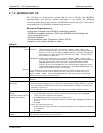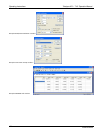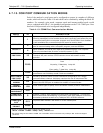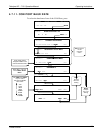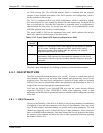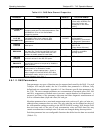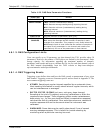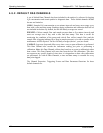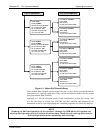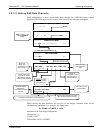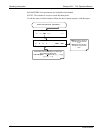
Operating Instructions Teledyne API – T101 Operation Manual
126
Table 4-21. DAS Data Channel Properties
PROPERTY DESCRIPTION DEFAULT SETTING RANGE
NAME
The name of the data channel. “NONE” Up to 6 letters and digits
(more with APICOM, but
only the first six are
displayed on the front
panel).
TRIGGERING
EVENT
The event that triggers the data channel to
measure and store its data parameters. See
APPENDIX A-5 for a list of available
triggering events.
ATIMER Any allowed event.
NUMBER AND
LIST OF
PARAMETERS
A User-configurable list of data types to be
recorded in any given channel. See
APPENDIX A-5 for a list of available
parameters
1 -
PMTDET
Any available
concentration,
temperature, pneumatic
or diagnostic parameter.
REPORT
PERIOD
The amount of time between each channel
data point.
000:01:00 000:00:01 to
366:23:59
(Days:Hours:Minutes)
NUMBER OF
RECORDS
The number of reports that will be stored in
the data file. Once the specified limit has
been exceeded, the oldest data are over-
written to make space for new data.
100 Configuration-dependent,
limited by available
storage space.
RS-232
REPORT
Enables the analyzer to automatically report
channel values to the RS-232 ports.
OFF OFF or ON
CHANNEL
ENABLED
Enables or disables the channel. Provides a
convenient means to temporarily disable a
data channel.
ON OFF or ON
CAL HOLD OFF
Disables sampling of data parameters while
instrument is in calibration mode.
Note that - when enabled here - there is
also a length of the DAS HOLD OFF after
calibration mode, which is set in the VARS
menu (Section 4.11.2.11.)
OFF OFF or ON
4.8.1.2. DAS Parameters
Data parameters are types of data that may be measured and stored by the DAS . For each
Teledyne API analyzer model, the list of available data parameters is different, fully
defined and not customizable. Appendix A-5 lists firmware specific data parameters for
the T101. The most common parameters are concentrations of measured gases (H
2
S, H
2
S
and NO
2
), temperatures of heated zones (converter, sample chamber, box temperature…),
pressures and flows of the pneumatic subsystem and other diagnostic measurements as
well as calibration data (slope and offset) for each gas.
Most data parameters have associated measurement units, such as mV, ppb, cm³/min, etc.,
although some parameters have no units. The only units that can be changed are those of
the concentration readings according to the SETUP-RANGE settings. Note that the DAS
does not keep track of the unit of each concentration value and DAS data files may
contain concentrations in multiple units if the unit was changed during data acquisition.
Each data parameter has user-configurable functions that define how the data are recorded
(Table 4-21).
07266B DCN6485




